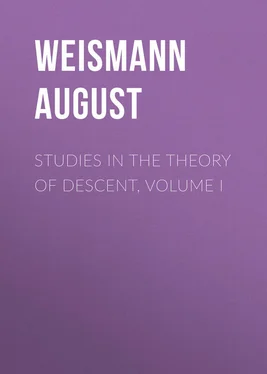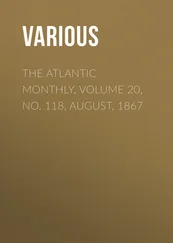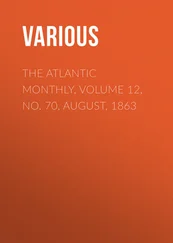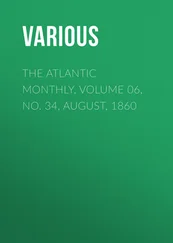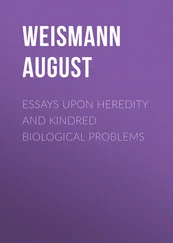August Weismann - Studies in the Theory of Descent, Volume I
Здесь есть возможность читать онлайн «August Weismann - Studies in the Theory of Descent, Volume I» — ознакомительный отрывок электронной книги совершенно бесплатно, а после прочтения отрывка купить полную версию. В некоторых случаях можно слушать аудио, скачать через торрент в формате fb2 и присутствует краткое содержание. Жанр: foreign_antique, foreign_prose, на английском языке. Описание произведения, (предисловие) а так же отзывы посетителей доступны на портале библиотеки ЛибКат.
- Название:Studies in the Theory of Descent, Volume I
- Автор:
- Жанр:
- Год:неизвестен
- ISBN:нет данных
- Рейтинг книги:4 / 5. Голосов: 1
-
Избранное:Добавить в избранное
- Отзывы:
-
Ваша оценка:
- 80
- 1
- 2
- 3
- 4
- 5
Studies in the Theory of Descent, Volume I: краткое содержание, описание и аннотация
Предлагаем к чтению аннотацию, описание, краткое содержание или предисловие (зависит от того, что написал сам автор книги «Studies in the Theory of Descent, Volume I»). Если вы не нашли необходимую информацию о книге — напишите в комментариях, мы постараемся отыскать её.
Studies in the Theory of Descent, Volume I — читать онлайн ознакомительный отрывок
Ниже представлен текст книги, разбитый по страницам. Система сохранения места последней прочитанной страницы, позволяет с удобством читать онлайн бесплатно книгу «Studies in the Theory of Descent, Volume I», без необходимости каждый раз заново искать на чём Вы остановились. Поставьте закладку, и сможете в любой момент перейти на страницу, на которой закончили чтение.
Интервал:
Закладка:
August Weismann
Studies in the Theory of Descent, Volume I
PREFATORY NOTICE
The present work by Professor Weismann, well known for his profound embryological investigations on the Diptera, will appear, I believe, to every naturalist extremely interesting and well deserving of careful study. Any one looking at the longitudinal and oblique stripes, often of various and bright colours, on the caterpillars of Sphinx-moths, would naturally be inclined to doubt whether these could be of the least use to the insect; in the olden time they would have been called freaks of Nature. But the present book shows that in most cases the colouring can hardly fail to be of high importance as a protection. This indeed was proved experimentally in one of the most curious instances described, in which the thickened anterior end of the caterpillar bears two large ocelli or eye-like spots, which give to the creature so formidable an appearance that birds were frightened away. But the mere explanation of the colouring of these caterpillars is but a very small part of the merit of the work. This mainly consists in the light thrown on the laws of variation and of inheritance by the facts given and discussed. There is also a valuable discussion on classification, as founded on characters displayed at different ages by animals belonging to the same group. Several distinguished naturalists maintain with much confidence that organic beings tend to vary and to rise in the scale, independently of the conditions to which they and their progenitors have been exposed; whilst others maintain that all variation is due to such exposure, though the manner in which the environment acts is as yet quite unknown. At the present time there is hardly any question in biology of more importance than this of the nature and causes of variability, and the reader will find in the present work an able discussion on the whole subject, which will probably lead him to pause before he admits the existence of an innate tendency to perfectibility. Finally, whoever compares the discussions in this volume with those published twenty years ago on any branch of Natural History, will see how wide and rich a field for study has been opened up through the principle of Evolution; and such fields, without the light shed on them by this principle, would for long or for ever have remained barren.
Charles Darwin.TRANSLATOR’S PREFACE
In offering to English readers this translation of Professor Weismann’s well-known “Studies in the Theory of Descent,” the main part of which is devoted to entomological subjects, I have been actuated by the desire of placing in the hands of English naturalists one of the most complete of recent contributions to the theory of Evolution as applied to the elucidation of certain interesting groups of facts offered by the insect world. Although many, if not most, working naturalists are already familiar with the results of Dr. Weismann’s researches, of which abstracts have from time to time appeared in English and American scientific journals, I nevertheless believe that a study of the complete work, by enabling the reader to follow closely the detailed lines of reasoning and methods of experiment employed by the author, will be found to be of considerable value to those biologists who have not been able to follow the somewhat difficult phraseology of the original. It is not my intention, nor would it be becoming in me to discuss here the merits of the results arrived at by the minute and laborious investigations with which Dr. Weismann has for many years occupied himself. I may however point out that before the appearance of the present work the author, in addition to his well-known papers on the embryology and development of insects, had published two valuable contributions to the theory of descent, viz. one entitled “Über die Berechtigung der Darwin’schen Theorie” (1868), and another “Über den Einfluss der Isolirung auf die Artbildung” (1872). These works, which are perhaps not so well known in this country as could be desired, might be advantageously studied in connection with the present volume wherein they are frequently referred to.
Since every new contribution to science is a fresh starting-point for future work, I may venture without any great breach of propriety to dwell briefly upon one or two of the main points which appear to me to be suggested by Prof. Weismann’s investigations.
Although the causes of Glacial Epochs is a subject which has much occupied the attention of geologists and physiographers, the question is one of such great complexity that it cannot yet be regarded as finally settled. But apart from the question of causes – a most able discussion of which is given by the author of “Island Life” – there is not the least doubt that at no very distant geological period there occurred such an epoch, which, although intermittent, was of considerable duration. The last great geological event which our globe experienced was in fact this Ice Age, and the pure naturalist has not hitherto attributed in my opinion sufficient importance to the direct modifying effects of this prolonged period of cold. It is scarcely possible that such a vast climatic change as that which came on at the close of the Pliocene Period should have left no permanent effect upon our present fauna and flora, all the species of which have survived from the glacial age. The great principle of Natural Selection leads us to see how pre-glacial forms may have become adapted to the new climatic conditions (which came on gradually) by the “survival of the fittest” or “indirect equilibration.” The influence of the last Glacial Epoch as a factor in determining the present geographical distribution of animals and plants has already been amply treated of by many writers since the broad paths were traced out by Darwin, Lyell, and Wallace. The last-named author has indeed quite recently discussed this branch of the subject most exhaustively in his work on “Island Life” above mentioned. The reference of a particular group of phenomena – the seasonal dimorphism of butterflies – to the direct action of the Glacial Period and the subsequent influence of the ameliorating climate, was however the first step taken in this neglected field by the author of the present work in 1875. It is possible, and indeed probable, that future researches will show that other characters among existing species can be traced to the same causes.
The great generalizations of embryology, which science owes so largely to the researches of Karl Ernst von Baer, bear to the theory of descent the same relations that Kepler’s laws bear to the theory of gravitation. These last-named laws are nothing more than generalized statements of the motions of the planets, which were devoid of meaning till the enunciation of the theory of gravitation. Similarly the generalized facts of embryology are meaningless except in the light of the theory of descent. It has now become a recognized principle in biology that animals in the course of their development from the ovum recapitulate more or less completely the phases through which their ancestors have passed. The practical application of this principle to the determination of the line of descent of any species or group of species is surrounded by difficulties, but attempts have been made of late years – as by Haeckel in his Gastrula theory – to push the law to its legitimate consequences. In this country Sir John Lubbock, in 1874, appealed to the embryonic characters of larvæ in support of his views on the origin of insects. To the author of this work (1876) is due the first application of the principle of Ontogeny as revealing the origin of the markings of caterpillars. A most valuable method of research is thus opened up, and entomologists should not be long in availing themselves of it. Our knowledge of the subject of larval development in Lepidoptera is still most imperfect, and it cannot as yet be foreseen to what extent the existing notions of classification in this much-studied order may have to be modified when a minute study of the Comparative Ontogeny of larval characters, worked out as completely as possible for each family, has enabled a true genealogical system to be drawn up. The extent to which such a larval genealogy would coincide with our present classification cannot now be decided, but he who approaches this fruitful line of inquiry in the true spirit of an investigator, will derive much instruction from Prof. Weismann’s remarks on “Phyletic Parallelism in Metamorphic Species.” The affinities of the larger groups among Lepidoptera would most probably be made out once and for ever if systematists would devote more time to observation in this field, and to the co-ordination and working up of the numerous data scattered throughout the vast number of entomological publications.
Читать дальшеИнтервал:
Закладка:
Похожие книги на «Studies in the Theory of Descent, Volume I»
Представляем Вашему вниманию похожие книги на «Studies in the Theory of Descent, Volume I» списком для выбора. Мы отобрали схожую по названию и смыслу литературу в надежде предоставить читателям больше вариантов отыскать новые, интересные, ещё непрочитанные произведения.
Обсуждение, отзывы о книге «Studies in the Theory of Descent, Volume I» и просто собственные мнения читателей. Оставьте ваши комментарии, напишите, что Вы думаете о произведении, его смысле или главных героях. Укажите что конкретно понравилось, а что нет, и почему Вы так считаете.
